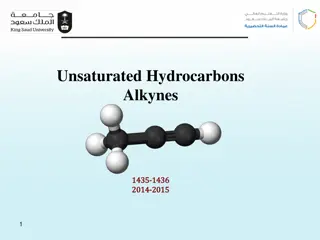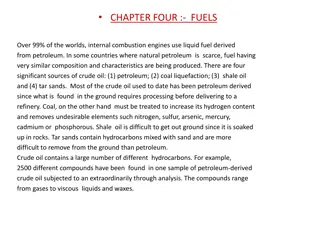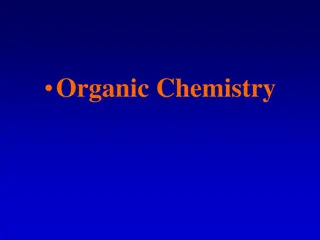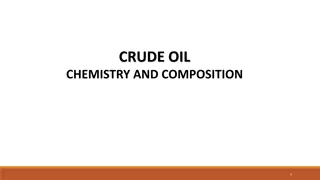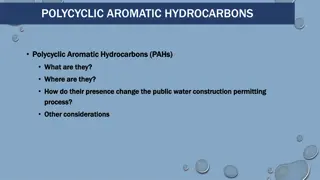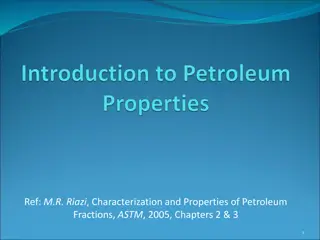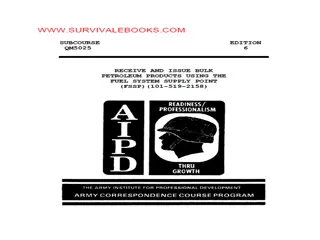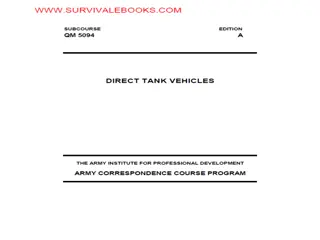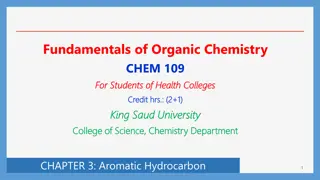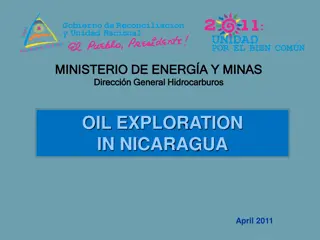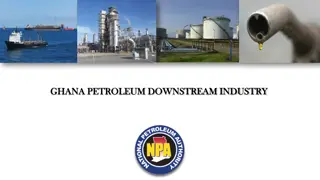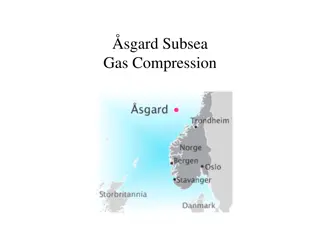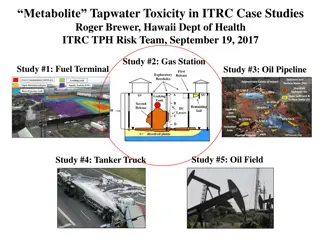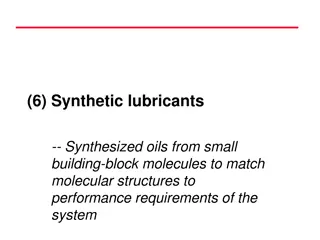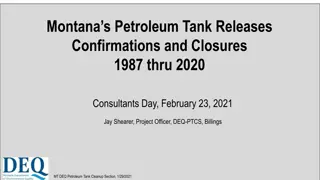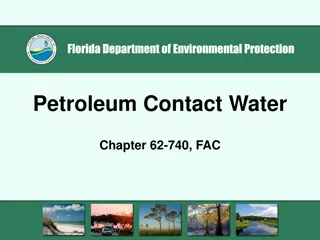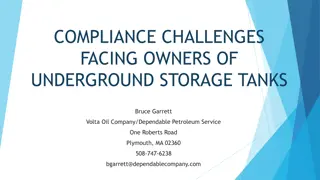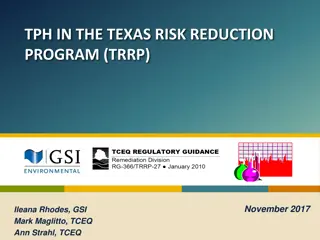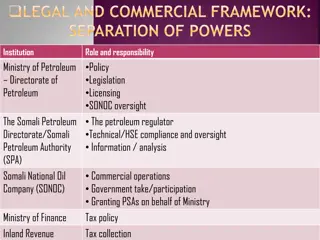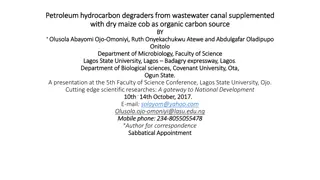Understanding Petroleum Hydrocarbons and Their Properties
Petroleum is a complex mixture of hydrocarbons, including paraffins, olefins, naphthenes, and aromatics. Paraffins are fully saturated and stable, olefins are unsaturated with double bonds, naphthenes are cyclic saturated hydrocarbons, and aromatics are cyclic unsaturated hydrocarbons containing benzene. Each group has distinct characteristics and plays a vital role in the composition and properties of petroleum fractions.
Download Presentation

Please find below an Image/Link to download the presentation.
The content on the website is provided AS IS for your information and personal use only. It may not be sold, licensed, or shared on other websites without obtaining consent from the author. Download presentation by click this link. If you encounter any issues during the download, it is possible that the publisher has removed the file from their server.
E N D
Presentation Transcript
Ref: M.R. Riazi, Characterization and Properties of Petroleum Fractions, ASTM, 2005, Chapter 1.1 1
Petroleum Definitions Petroleum is a complex mixture of hydrocarbons that occur in the sedimentary rocks in the form of gases (natural gas), liquids (crude oil), semisolids (bitumen), or solids (wax or asphaltite). An underground reservoir that contains hydrocarbons is called petroleum reservoir and its hydrocarbon contents that can be recovered through a producing well is called reservoir fluid. 2
Petroleum Definitions Paraffins Generally, hydrocarbons are divided into four groups: paraffins, olefins, naphthenes and aromatics. Paraffins are also called alkanes and have the general formula of CnH2n+2, where n is the number of carbon atoms. Paraffins from C1 to C40 usually appear in crude oil and represent up to 20% of crude by volume. Since paraffins are fully saturated (no double bond), they are stable and remain unchanged over long periods of geological time. 3
Petroleum Definitions Olefins Olefins are another series of noncyclic hydrocarbons but they are unsaturated and have at least one double bond between carbon-carbon atoms. Compounds with one double bond are called monoolefins or alkenes. Monoolefins have a general formula of CnH2n. Olefins are uncommon in crude oils due to their reactivity with hydrogen that makes them saturated; however, they can be produced in refineries through cracking reactions. 4
Petroleum Definitions Naphthenes Naphthenes or cycloalkanes are ring or cyclic saturated hydrocarbons with the general formula of CnH2n. Cyclopentane (C5H10), cyclohexane (C6H12), and their derivatives such as n-alkylcyclopentanes are normally found in crude oils. Thermodynamic studies show that naphthene rings with five and six carbon atoms are the most stable naphthenic hydrocarbons. The content of cycloparaffins in petroleum may vary up to 60%. 5
Petroleum Definitions Aromatics Aromaticsare an important series of hydrocarbons found in almost every petroleum mixture from any part of the world. Aromatics are cyclic but unsaturated hydrocarbons that begin with benzene molecule (C6H6) and contain carbon-carbon double bonds. Some of the common aromatics found in petroleum and crude oils are benzene and its derivatives with attached methyl, ethyl, propyl, or higher alkyl groups. This series of aromatics is called alkylbenzenes and have a general formula of CnH2n-6 (where n 6). 6
Petroleum Definitions Sulfur Content Sulfur is the most important heteroatom in petroleum and it can be found in cyclic as well as noncyclic compounds such as mercaptanes (R-S-H) and sulfides (R-S-R ), where R and R are alkyl groups. Sulfur in natural gas is usually found in the form of hydrogen sulfide (H2S). Some natural gas contain H2S as high as 30% by volume. The amount of sulfur in a crude may vary from 0.05 to 6% by weight. 7
Petroleum Definitions Reservoir Fluid Reservoir fluid is a term used for the mixture of hydrocarbons in the reservoir or the stream leaving a producing well. Three factors determine if a reservoir fluid is in the form of gas, liquid, or a mixture of gas and liquid. These factors are (1) composition of reservoir fluid, (2) temperature, (3) pressure. 8
Petroleum Definitions Gas-to-Oil Ratio The most important characteristic of a reservoir fluid in addition to specific gravity (or API gravity) is its gas-to- oil ratio (GOR), which represents the amount of gas produced at SC in standard cubic feet (scf) to the amount of liquid oil produced at the SC in stock tank barrel (stb). Generally, reservoir fluids are black oil, volatile oil, gas condensate, wet gas, and dry gas. 9
Petroleum Definitions Dry and Wet Gases If a gas after surface separator, under SC, does not produce any liquid oil, it is called dry gas. A natural gas that after production at the surface facilities can produce a little liquid oil is called wet gas. The word wet does not mean that the gas is wet with water, but refers to the hydrocarbon liquids that condense at surface conditions. 10
Petroleum Definitions Crude Oil Reservoir fluids from a producing well are conducted to two- or three-stage separators which reduce the pressure and temperature of the stream to atmospheric pressure and temperature. The liquid leaving the last stage is called stock tank oil (STO) and the gas released in various stages is called associated gas. The liquid oil after necessary field processing is called crude oil. 11
Petroleum Definitions Crude Oil The crude oil produced from the atmospheric separator has a composition different from the reservoir fluid from a producing well. Two important characterisitics of a crude that determine its quality are the API gravity (specific gravity) and the sulfur content. Generally, a crude with the API gravity of less than 20-22 is called heavy crude and with API gravity of greater than 33-40 is called light crude. Similarly, if the sulfur content of a crude is less than 0.5 wt% it is called a sweet oil. 12
Petroleum Refineries A crude oil produced after necessary field processing and surface operations is transferred to a refinery where it is processed and converted into various useful products. Refining processes can be generally divided into three major types: (1) separation, (2) conversion, and (3) finishing. The most important separation process is distillation that occurs in a distillation column; compounds are separated based on the difference in their boiling points. 13
Petroleum Refineries The conversion process consists of chemical changes that occur with hydrocarbons in reactors. The most important reaction in modem refineries is the cracking (catalytic and thermal) in which heavy hydrocarbons are converted to lighter and more valuable hydrocarbons. Other types of reactions such as isomerization or alkylation are used to produce high octane number gasoline. Finishing is the purification of various product streams by processes such as desulfurization to remove impurities from the product or to stabilize it. 14
Petroleum Refineries After the desalting process in a refinery, the crude oil enters the atmospheric distillation column. Hydrocarbons in a crude oil have boiling points ranging from -160 oC to more than 600 oC. The carbon-carbon bond in hydrocarbons breaks down at temperatures around 350 oC. So, compounds having boiling points above 350 oC (called residuum) are removed from the bottom of atmospheric distillation column and sent to a vacuum distillation column. The pressure in a vacuum distillation column is about 50-100 mm Hg. 15
Petroleum Fractions Since distillation cannot completely separate the compounds, there is no pure hydrocarbon as a product of a distillation column. A group of hydrocarbons can be separated through distillation according to a boiling point range. These products are called petroleum fractions. All fractions from a distillation column have a known boiling range, except the residuum for which the upper boiling point is usually not known. The boiling point of the heaviest component in a crude oil is not really known, but it is quite high. 16
Petroleum Fractions Some of the petroleum fractions produced from distillation columns with their boiling point ranges are given in Table below. These fractions may go through further processes to produce desired products. 17
Petroleum Standards There are a number of international standard organizations that recommend specific characteristics or standard measuring techniques for various petroleum products. Some of these organizations are as follows: 1. ASTM (American Society for Testing and Materials) in the United States 2. ISO (International Organization for Standardization), which is at the international level 3. IP (Institute of Petroleum) in the United Kingdom 4. API (American Petroleum Institute) in the United States 18
Petroleum Standards ASTM is composed of several committees in which the D- 02 committee is responsible for petroleum products and lubricants, and for this reason its test methods for petroleum materials are designated by the prefix D. For example, the test method ASTM D 2267 provides a standard procedure to determine the benzene content of gasoline. Most standard test methods in different countries are very similar in practice and follow ASTM methods but they are designated by different codes. 19


